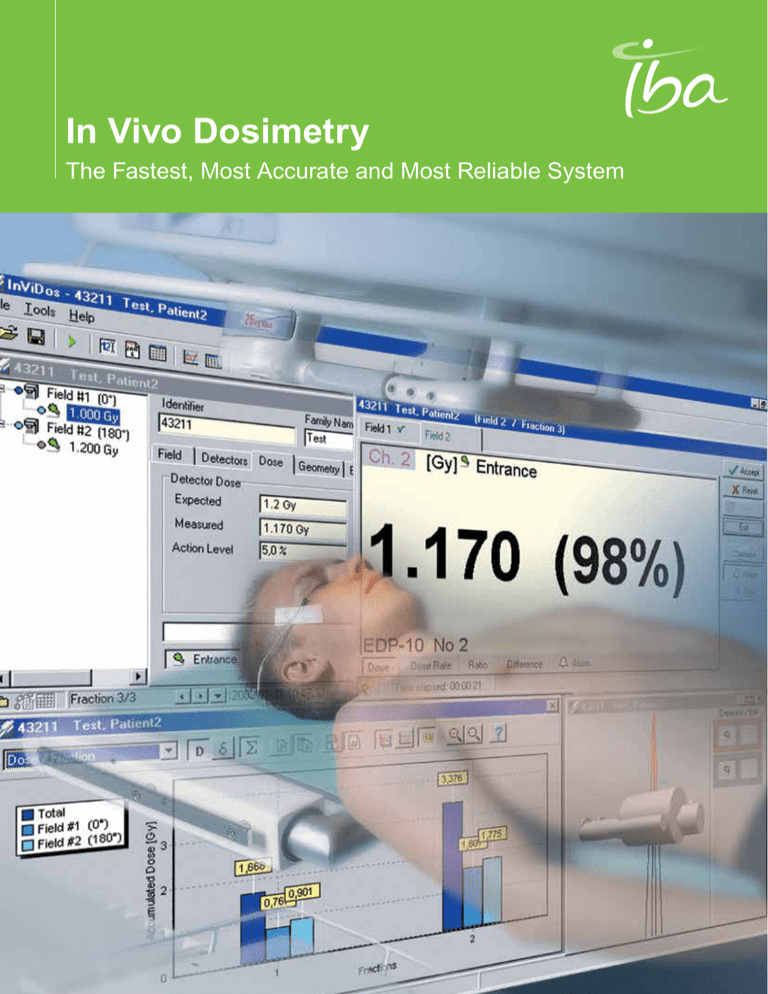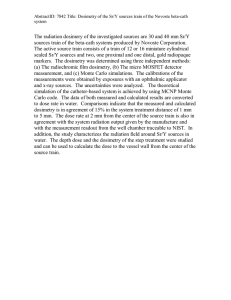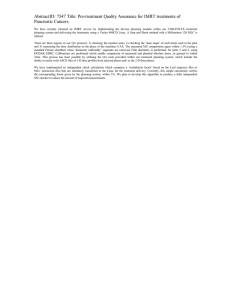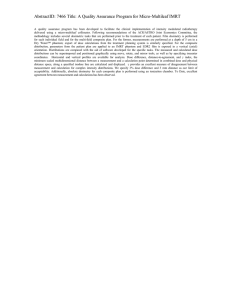
In Vivo Dosimetry
The Fastest, Most Accurate and Most Reliable System
In Vivo
treatment verification
➤ Calibration Wizard in OmniPro-InViDos guides
through new detector set-up
➤ User definable templates
➤ Low recalibration frequency of the detectors
➤ Independent patient database simplifies
patient selection
➤ Several presentation formats of data per field,
per fraction, accumulated dose, etc.
➤ Verification of treatment and delivered dose
by detecting systematical and stochastic
errors in radiation therapy
➤ Straightforward detector calibration performed
in OmniPro-InViDos
➤ 3 years detector warranty
The rapid development of advanced treatment
­techniques and planning places higher demands
on the verification of the dose delivered to the
­patient. In Vivo Dosimetry is an essential
element in the quality assurance program used
in today’s radiotherapy department. In several
European ­countries In Vivo Dosimetry has become
­mandatory, based on the directive “Medical
Exposure Directive 97/43/Euratom”.
Furthermore In Vivo Dosimetry is used to control
the total accumulated dose in cases where
the treatment planning system is less accurate,
such as in total body irradiation (TBI), in the
build-up region and in risk organs in the head and
neck region.
OmniPro-InViDos
Electrometer
2 IBA DOSIMETRY IN VIVO DOSIMETRY
Detectors
Efficient management system
for all tasks of In Vivo Dosimetry
OmniPro-InViDos is a dosimetry management system which h
­ andles all tasks of In Vivo Dosimetry.
It simplifies the use of In Vivo Dosimetry by giving the user an overview of the calibration, together
with tools to perform the calibration in an efficient way and by automatically s
­ electing correction
factors for each field. OmniPro-InViDos provides instruments for improving the accuracy of the
­treatment whilst reducing the time spent for In Vivo Dosimetry. It may be linked to the verification and
therapy system, either locally on the same PC as the verification system, or via the internal network.
The dose can be displayed as the dose in Dmax
or as the calculated dose in the prescription point.
The dose can e
­ ither be calculated from entrance/
exit dose measurements or by using the TPS
calculated relation between Dmax and the
prescription point. This ­provides the user with
essential information about the currently delivered
dose and the a
­ ccumulated dose from multiple
fields.
The patient database can be used to generate
reports of the patient history and the dose
received. OmniPro-InViDos can list all
measurements of ­different patients performed
within a defined period of time, providing a
measurement overview.
Dose calculation in the prescription point:
Depth dose measurement
relative dose (%)
Control, display and calculation of the dose
OmniPro-InViDos gives the user control over the
dose in each fraction and the cumulative dose
to the patient. It keeps track of the entrance and
exit dose to risk organs. For multiple field
treatment OmniPro-InViDos monitors the entrance
and exit dose for each field calculating the dose
in the target volume. A detector that is used for
­entrance dose measurements is automatically
reconfigured for exit dose measurements when
applying two opposite fields.
Treatment Planning
Treatment Planning:
160
dose
100
Dmax
80
60
depth
40
20
0
target volume
0
40
80
120
160
200
240
depth (mm)
Dose in target volume
Field dose in prescription point:
TPS
The data can be presented in several formats:
➤ Per field in the calibration point
➤ Per fraction in the prescription point
➤ Accumulated dose and biological effect
reliable RTPSinformation
entrance + exit dose
beam
beam
prescription
point
3 IBA DOSIMETRY IN VIVO DOSIMETRY
Fast and easy set-up
OmniPro-InViDos has all information about the
­instrumentation used and their calibration.
This ensures that all data is ­consistent in the
system even if a patient is transferred to ­another
treatment room or if a detector is changed.
Integration with record and verification systems
OmniPro-InViDos seamlessly integrates the
techniques used for In Vivo Dosimetry with the
daily used record and verification systems. Due to
the direct and c
­ on­tinuous communication it saves
time by providing:
➤ Automated set-up
➤ Correct mapping of patient data and dosimetry
system data
➤ Information about the patient ID, fields and
fractions; the treatment device that is used only
needs to be entered once
➤ Automated selection of the correct dosimetry set whenever a treatment schedule is changed in the
verification system
➤ Network solution that allows transfer of the patient
to another machine without need of redefining
the dosimetry set-up
➤ Import of patient data from all record and
verification systems that support RTP Link or
RTPConnect (e.g. Lantis/Aria/Mosaiq)
4 IBA DOSIMETRY IN VIVO DOSIMETRY
➤
➤
➤
➤
Furthermore it offers:
Independent patient database for the therapist
to simply select the patient; when connected to the
verification system, the selection is done ­
automatically
Similar treatments can use a similar dosimetry
set-up: the use of templates makes it very easy to
define which measurements shall be performed
and the typical instrumentation to be used
Scheduling of measurements; if an additional
­measurement is done this is easily added to the
scheme
Graphic outlining of the placement of each
detector on the patient, to ensure that the
measurements are done at the correct position
Calibration wizard
A calibration wizard optimizes the calibration and
provides the user with an overview of the process
together with tools to ­perform the calibration:
➤ Administration of correction factors by the system
➤ Automatic selection of correction factors for
each field
➤ Guided calibration process when a new detector
is used
➤ In case of a multi-modality machine, the use of ­
correction factor multiplicity considerably reduces
the number of calibrations
➤ Possibility to choose the order of calibrations
to perform
➤ When the accumulated dose received by the
detector exceeds a predefined level,
a recalibration is suggested by the system
➤ The need for recalibration is minimized by dividing
the calibration set into correction and sensitivity
➤ When the correction factors for energy, field size,
SSD, etc. have been measured, it is sufficient to
make a sensitivity recalibration of the detectors on
a regular basis
Electrometers
OmniPro-InViDos supports the DPD-3* and DPD-12
(emX), and it can even use 2 emX in cascade to
increase the ­number of ­detectors simultaneously
used up to 24. OmniPro-InViDos also ­supports the
former model DPD-510.
Detectors
Any In Vivo detector from IBA Dosimetry can be
used with the OmniPro-InViDos system. The
­calibration wizard and automatic ­correction set
selection is specially designed to handle our
detectors.
* Not sold in countries requiring the CE marking.
5 IBA DOSIMETRY IN VIVO DOSIMETRY
The In Vivo patient dosemeter
Together with the wide range of renowned high
quality 3G-pSi detectors, the DPD-3* system can
handle a variety of treatment situations:
entrance dose, exit dose and risk organ monitoring.
The electrometer works as a stand-alone
system but also comes standard with a serial
communication port for control from a personal
computer.
The DPD-3* is a 3-channel electrometer system.
­Typically, two of the channels are used for photon
and electron energies and the third for risk organ
monitoring.
To allow high precision measurements with a
minimum of work load, the calibration factor has
been divided into a ­sensitivity factor correlated to
the detector sensitivity and a correction factor.
The DPD-3* is designed for ease of use,
particularly in routine situations. Clinics demanding
a high accuracy can define up to 99 correction
factors which correct for different physical
conditions in varying measurement situations.
Commonly used functions such as selection of
correction factors, printing results and
electrometer reset are accessed through separate,
clearly marked keys. A large LCD display for each
channel is easily readable from a distance.
When a recalibration has to be done due to
change in ­detector sensitivity, only the
corresponding sensitivity factor has to be updated.
The user defined correction factors can be used
unchanged.
* Not sold in countries requiring the CE marking.
6 IBA DOSIMETRY IN VIVO DOSIMETRY
The In Vivo 3G-pSi detectors
The IBA Dosimetry 3G-pSi detectors are ­designed to facilitate the implementation
of a fast and accurate In Vivo Dosimetry routine.
➤ Proven long-term stability
➤ Low recalibration frequency
➤ Dose rate independence
➤ Build-up caps: – optimized for low field
perturbation
– minimized field size and
directional dependencies
– reduce the need for
corrections
– low temperature
dependence
Application area
Photons
(1
Detector
Application area
build-up
EDD-23G (grey)
EDD-53G (black)
EDP-53G (blue)
EDP-103G (green)
EDP-153G (red)
EDP-203G (yellow) EDP-HL3G (white)
Electrons
Cobalt
Entrance dose, few correctionsEDP-10 3G (4-8 MV*)
EDD-23GEDP-53G
EDP-153G (6-12 MV*)
EDP-53G
EDP-203G (8-16 MV*)
EDP-HL3G (16-21 MV*)
Total body irradiation (TBI)
EDD-53G (1– –
Entrance dose, EDD-23GEDD-23GEDD-23G
low field perturbationEDP-HL3G (16-21 MV*)
EDD-23G
Exit doseEDD-23G; any detector –
can be used
Risk organ monitoring, EDD-53GEDD-53GEDD-53G
measurements outside the field
entrance dose, few corrections, low field perturbation, low directional dependence, exit dose
risk organ monitoring, TBI, low directional dependence,
exit dose
entrance dose, few corrections, exit dose
4-8 MV (Photons), entrance dose,
few corrections, exit dose
6-12 MV (Photons), entrance dose,
few corrections, exit dose
8-16 MV (Photons), entrance dose,
few corrections, exit dose
16-21 MV (Photons), entrance dose,
few corrections, low field perturbation, exit dose
* Based on build-up thickness and composition.
When using spoiler (build-up), otherwise same r­ecommendations as entrance dose, few corrections.
Water equivalent
Sensitivity decrease measured at 250 Gy 2 mm
5 mm drop shaped
encapsulation
5 mm <1% (less than the meas. accuracy) in 60C
10 mm
<1% (less than the meas. accuracy) at 6 MV
15 mm
<1% (less than the meas. accuracy) at 6 MV
20 mm
<1% at 15 MV
14 mm
<1% at 15 MV
<1% (less than the meas. accuracy) in 60Co
<1% (less than the meas. accuracy) in 60Co
A 3-year warranty is standard on all ­detectors. This guarantees high ­usage capability at low lifetime
costs and ­demonstrates the unsurpassed accuracy and life expectancy of these detectors.
7 IBA DOSIMETRY IN VIVO DOSIMETRY
Accessories
Detector support
The detector support with automatic detector
retraction is a significant time saving device.
Additionally, it provides a safe, tangle free
­environment for the detectors when not in use.
It can be configured with all available detector
cable lengths.
The mechanics allow a detector to be pulled out
to any length up to 3.50 m at constant force.
The cable locks into position by simply moving it
towards the central axis of the support and retracts
­automatically when it is moved out from the centre.
Additionally, the support has an integrated
numerical index which ­clearly identifies each
detector, thus helping to ensure that the correct
detector is chosen for a given procedure.
8 IBA DOSIMETRY IN VIVO DOSIMETRY
Temperature calibration phantom
IBA detectors have a low temperature dependency
(0.25 % / C°), so only a few corrections are
required. However, an easy way to ­handle the
correction process is to use the calibration
­phantom, which allows the user to calibrate the
detectors at skin ­temperature, thus eliminating
the need for later ­corrections. To achieve skin
­temperature the phantom should be filled with 40°
water. The water temperature may be ­checked
with the accompanying thermometer.
Technical specifications
OmniPro-InViDos
Processor:
2 GHz
Random access memory:
1 GB
Free disk space:
120 GB
Serial port:
RS-232, for electrometer communication
Screen resolution:
16-bit colors and 1024 x 768 pixels
System software:Windows® 2000 SP4, or XP SP2
Microsoft Data Access Components (MDAC), version 2.7 or later
Drivers:OpenGL
Additional requirements for Visir: VISIR version 1.3A or later, SYBASE ODBC driver
Electrometers
DPD-3
DPD-12 (emX)
Input channels:
3
Range dose:
up to 7 Gy*
Accuracy:
better than 0.5%
(zero drift compensated)
Connectors:
3 x BNC
Cable:
3 x 20 m BNC-BNC
Front display:yes
Interface:RS-232
12 (24 in cascade)
up to 7 Gy*
better than 0.5%
(zero drift compensated)
37 pin D-sub
15 m RS-232, 10 m detector cable
no
RS-232
Temperature calibration phantom, external detectors
Size:
295 mm (L) x 295 mm (W) x 50 mm (H)
Material:PMMA
including 1 thermometer
Detector support
Size:
1080 x Ø 250 mm
Weight:
21 kg (26 with cables)
Number of mountable detectors: 12 (cables to be included)
Mounting console:
(to be used when ceiling is higher than 3 m)
Adjustable length:
200 – 1000 mm
Weight:
14 kg (full length)
3G-pSi detectors, general specifications
Typical sensitivity:
100 nC/Gy
SVWT:0.25%/°C
Diameter of active area:
1.6 mm
Cable length:
4 m (2 m on request)
* With 3G-pSi detectors
9 IBA DOSIMETRY IN VIVO DOSIMETRY
Technical specifications
External detectors
EDD-23GEDD-53GEDP-53G
Build-up material/
Epoxy and Si
PVC, epoxy
Polystyrene
encapsulation:
and Si
and epoxy
Perturbation, typical values
at 5 cm depth in
recommended energy: 1%
1%
Directional dependence,
axial: <2% in
axial: <2% in
axial and tilt: the range ±10° the range ±45°; <3% in the
in recommended energy: (2
tilt: <2% in the tilt: <2% in the range ±45°
range ±10°;
range ±10°;
-2/+14% in the -3/+7% in the
range ±40°
range ±40°
<1% in 60Co,
<1% in 60Co,
Sensitivity decrease
<1% in 60Co, per 250 Gy:
6 MV, 15 MV
6 MV, 15 MV
6 MV, 15 MV
Physical dimensions:
width
8 mm
5 mm
12 mm
thickness
3.5 mm
11.5 mm
6.5 mm
EDP-103G, -153G, -203GEDP-HL3G
Stainless steel
Tanthal
and epoxy
5-6%
axial and tilt: <3% in the
range ±45°
2-3% (1 axial and tilt:
<3% in the
range ±30°
<1% in 60Co,
6 MV, 15 MV
<1% in 60Co,
6 MV, 15 MV
12 mm
6.5 mm
12 mm
6.5 mm
Directional
dependence:
axial = a
tilt = b
(1
(2
In the range of 16-18 MV.
Evaluated with a diode fixed on the surface of a plastic slab by rotating the gantry.
Technical data is subject to change without prior notice.
10 IBA DOSIMETRY IN VIVO DOSIMETRY
11 IBA DOSIMETRY IN VIVO DOSIMETRY
IBA offers innovative high-quality
solutions and services with
a focus on patient safety in cancer
diagnosis and therapy.
Medical Imaging:
Safer Imaging, Earlier Cancer Detection
➤Innovative Quality Assurance (QA) devices for x-ray dose and image quality checks, as well as QA of diagnostic displays
➤Patient dose monitoring solutions for x-ray imaging systems
Radiation Therapy:
Fighting Cancer Safely and Precisely
➤Industry-leading dosimetry and QA solutions that maximize
efficiency and minimize errors for better outcomes
➤Flexible soft tissue imaging markers (VISICOIL™) enable precise tumor targeting and tracking for pinpoint RT, IGRT and SBRT treatment accuracy and patient safety
➤Undisputed leader in Proton Therapy delivery systems:
Providing highly precise and effective radiation therapy
www.iba-dosimetry.com
Contact details:
dosimetry-info@iba-group.com
Europe, Middle East, Africa
IBA Dosimetry GmbH
Bahnhofstr. 5
90592 Schwarzenbruck, Germany
Tel.: +49 9128 607 0
Fax: +49 9128 607 10
North America, Latin America
IBA Dosimetry America
3150 Stage Post Drive, Suite 110
Bartlett, TN 38133, USA
Tel.: +1 901 386 2242
Fax: +1 901 382 9453
Asia Pacific
IBA Dosimetry Asia Pacific
No.6, Xing Guang Er Jie Beijing
OPTO-mechatronics
Industrial Park (OIP),
Tongzhou District
Beijing 101111, China
Tel.: +86 10 8080 9288
Fax: +86 10 8080 9299
RT-BR-E-InVivo_Rev.2_0813 | © IBA 2013 | All rights reserved Manufacturer: IBA Dosimetry GmbH
IBA in a Nutshell




